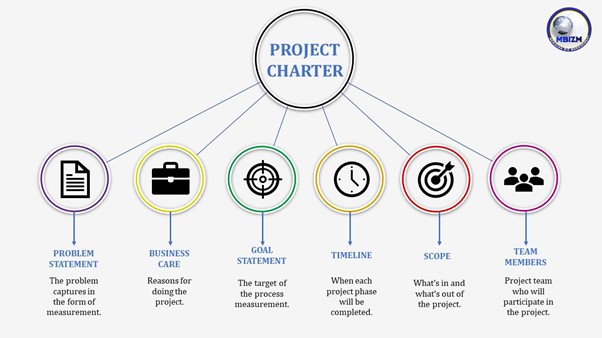What is A Project Charter?
Establishing a project charter is the first step and the most fundamental one in the Lean Six Sigma methodology. Project Charter is a document that officiates and formalizes the existence of a project. It is a document that provides high-level information on all aspects of the project, right from the most straightforward information like the title of the project to the most important information on the project’s Cost-Benefit analysis. Project Charter contains all crucial aspects of the project in a crisp format for it to be easily understood, reviewed, and approved by everyone involved in the project. Project Charter will need to be developed at the beginning of the DMAIC cycle at the Define Phase.
The main purpose of the project charter is the formal authorization of the project. Without a project charter, the project can easily be cancelled anytime as there is no valid proof or documentation. In auditing terms, absence of a project charter could be classified as a major non-conformance and audited as an unauthorized project. Project charter is akin to a guideline to direct the project team accordingly so that the objectives of the project which they are doing are achievable and the scope of the projects can be clearly defined.
The importance of Project charter is it is very crucial in that it can either make or break the project. For example, let’s consider a project XYZ which has already started three months; everything is already authorized, and the project is going on very well. However, due to unavoidable circumstances, the current Project Manager resigned from the company, but the project has to go on as scheduled. Hence, a new project manager is taking over the project, and he has to go through the project charter to understand the flow of the project, the business need, and the objective. Project charter with detailed information such as the objectives, scope, cost-benefit analysis, and stakeholders will enable the newly appointed project manager to take over the project successfully with minor disruption.
Components of the Project Charter
A project charter is a living document outlining issues, targets, and the framework of a process improvement effort by a company. It consists of six main components. Each component helps define the reasons for the project, explain how it helps improve the business, enumerate what steps are necessary, and identify the stakeholders responsible for the project. The project charter components are:
Problem statement: The problem captures in the form of a measurement.
Business case: The business reasons for doing the project.
Goal statement: The target of the process measurement.
Timeline: When each project phase will be completed
Scope: What’s in and what’s out of the project
Team members: The people who will participate in the project

The Importance Of Project Charter Structure
- Project Title: A one line title that is represents the project. For example, Improving Cycle Time of producing outer case of a Smartphone.
- Project Champion (Process Owner, Sponsor & Champion can be the same person depending on the organization’s hierarchy)
- Project Internal-Scope: This should capture the details of the process or sub processes that are In Scope for improving as a part of the Project. This will ensure a clear path to be followed and avoid any discrepancy at a later stage.
- Project external-Scope: A list of Out-of-Scope processes, sub-processes or steps should be clearly defined to avoid any clashes during Project progression.
- Project Stage Timeline: This should capture the Planned Date for completing each Stage/Phase of the Project (Define, Measure, Analysis, Improve, Control in case of DMAIC; Define, Measure, Analysis, Design and Verify in case of DMADV; Ideate, Design, Optimize and Verify in case of IDOV. DMADV and IDOV are part of Design for Six Sigma – DFSS). Against each Planned Date there should be a column for Actual Date to track the progress of the Project against the Actual Plan.
- Team Members: The list of Team Members who would be working on the Project should be available. Their Roles should be stated along with the number of hours they would be engaged in the Improvement Project (hours engaged each day or per week depending on the Project requirement). This will help in efficient utilization of the resources efficiently. These details will help the Team Members to plan and prioritize their activities without impacting their regular work or Project related work.
- Cost Benefit Analysis: This should give an estimate of the cost that would be incurred for the Project and the Benefits that would be achieved after the Project. A final amount will be available after analysing the Costs and Benefits which will be of interest to the stakeholders and Top Management in order to give a go ahead for any Project.
- Signature of Stakeholders: Signature of the Stakeholders (Project Coach, Project Sponsor and Project Champion) should be taken which will flag it as an officially approved Project to be kick started.
Purpose of Project Charter
The main project charter purpose is to justify the company’s need for the project in terms of potential benefits versus costs, time, and resources to approve the project. At the same time, the document serves these purposes:
To have a clear budget estimation and resources:
Project charter provides budget estimation of how much the project cost and which team is needed to handle the project. Therefore, it helps to determine whether the project team can handle all the requirements needed according to the company’s budget. Therefore, it helps to reduce the risk of spend unnecessarily on a project and the project team shall aware whether they can afford to handle the project.
As reference for future project
Project charter is commonly use as a reference for project planning the future. The project charter only covers the basic information needed in the project; it helps the project manager in planning the actual activities required. Such as, the estimated cost of a project serves as a fundamental to obtain necessary resources. Not only that, the project team can use the project charter as a reference for them to avoid taking on work beyond the scope of the approved project.
Improve project communication
A crucial importance of Project charter is that it helps identify stakeholders and their roles and responsibilities related to the project as it allows the entire project team to be informed. The project team can identify the individuals responsible for specific tasks to avoid confusion that may lead to mistakes and the disruption of the project execution process.
Identify potential problems
Another importance of project charter is that it can also be used as an essential risk assessment tool to help the project team prepare for potential problems that may occur in the future. For example, by using the project charter as a reference, the project team may cite scope and budget as two risks they need to focus on. The project team can monitor changes meticulously to ensure the activities are according to budget so that the company does not have to drop the project due to a lack of financial resources.
Allow for negotiation about project details
If the stakeholders initially reject the project, the project charter serves as crucial documentation that allows for further negotiation to obtain approval. For example, stakeholders can look closely at the project and resource requirements and possibly negotiate on scope, cost, or human resource needs.
MBizM Sdn Bhd provides various Lean Six Sigma training stages such as Yellow Belt, Green Belt, Black Belt, and Master Black Belt. Our Lean Six Sigma consultants and trainers are Lean Six Sigma certified, and they have conducted training for many years for clients in different industries. For your information, Lean Sigma Experts Australia is an Accredited Training Organization, Curriculum Provider and Examination Center by IASCC and by Council for Six Sigma Certification. We offer the best price for Lean Six Sigma Training in Australia with certified trainers and complimentary training materials. If you wish to learn more about process mapping and Lean Six Sigma training, visit our website at https://mbizm.com/ to learn more about our Lean Six Sigma programmes.


